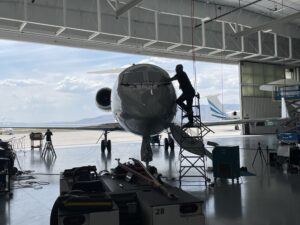- July 7, 2024
- Comments Off on The Art of Capturing Great Photographs of Airplanes at Airshows
- Posted by Aviation_Photographer
- Photography
The Art of Capturing Great Photographs of Airplanes at Airshows
Aviation Photography Tips for Capturing Great Aircraft Images
Airshows captivate with their high-speed jets, graceful prop planes, and the daring maneuvers that defy gravity. For aviation photographers, these events offer an unparalleled opportunity to capture the essence of aviation in its most thrilling form. However, to truly encapsulate the speed, agility, and beauty of these aircraft, one must go beyond simply pointing and shooting. This blog post is dedicated to the art and science of shooting airplanes at airshows, utilizing a blend of reliable techniques and artistic innovation, ensuring that every shot is not just a photograph, but a masterpiece.
Part 1: Positioning and Preparation
Positioning Is Key
Securing a vantage point with an unobstructed view is crucial. Remember, even if the crowd turns with the action, taller spectators can obstruct your view. Aim for a spot that offers the widest possible angle to the sky, ensuring that your shots are free from unwanted distractions.
Reliable Gear and Settings
Equipping yourself with a long lens (200mm at the very minimum) is non-negotiable for capturing the action in the sky. For ground shots, a versatile 24-70mm lens can work wonders, but don’t shy away from going wide with a 14-24mm lens for those dramatic, up-close images that make aircraft look monumental.
When shooting jets, a manual setting with a fast shutter speed is essential to freeze motion, aiming for shutter speeds that allow you to keep the ISO under 1200 for the sharpest images. For propeller aircraft and helicopters, shutter priority mode with a speed of 1/25 to 1/125 second will ensure that prop blur that conveys motion and energy.
Part 2: The Technique
The Art of Panning
Mastering the pan is pivotal. Focus on the aircraft early, keeping it centered as you smoothly follow its trajectory. This technique, when perfected, results in crisp images of the aircraft against a beautifully blurred background, conveying a sense of speed and motion.
Shutter Speeds for Different Aircraft
Jets demand a much faster shutter speed to freeze their rapid motion, while prop planes and helicopters benefit from a slower shutter speed to achieve that full circle blur of the propellers, adding a layer of realism and movement to your shots.
Part 3: Beyond the Basics
Innovative Shots and Exquisite Details
Don’t just capture the aircraft; look to find the essence of flight. Experiment with shutter speeds on acts that might not be your primary focus. This playful experimentation can lead to some pioneering shots that stand out in your portfolio.
The Passion for Perfection
Shooting at airshows is a game of persistence and passion. Adopting a “spray and pray” approach might seem unorthodox, but in the fast-paced environment of an airshow, it ensures you capture those split-second moments that define the event. Be prepared with plenty of memory cards, as shooting thousands of images is not just recommended; it’s a necessity.
Collaborative Spirit
Engage with fellow photographers and enthusiasts. Share tips, spots, and moments. The collaborative atmosphere at airshows can lead to learning new techniques or even finding the perfect shooting location you might have overlooked.
Photographing airplanes at airshows is more than just a technical challenge; it’s an art form that requires a passion for aviation and a dedication to the craft of photography. It’s about creating a refined and exquisite portrayal of aircraft, capturing their superior design and the pioneering spirit of aviation. Remember to enjoy the process, experiment with your techniques, and always be prepared for the next breathtaking moment that soars into view.
And never forget: wear sunscreen, stay hydrated, and embrace the joy of aviation photography with every shot you take.
Views: 49





